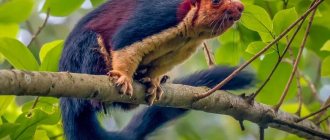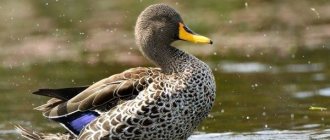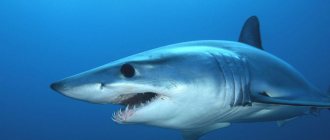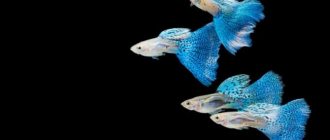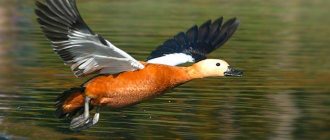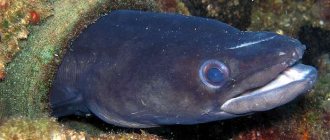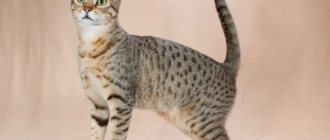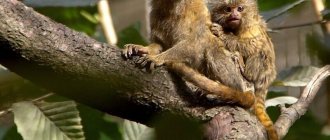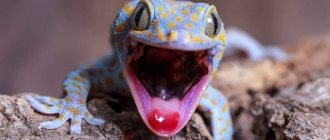A very beautiful species of bird of the duck family, which is famous for its bright coloring. This bird is quite small in size. Its mass does not exceed 700 grams; usually its weight ranges from 400 to 700 grams. The body length is also small - about 40 - 50 cm. The wing length of the mandarin duck is 21-25 cm.
Appearance
According to many people, it is the Mandarin duck that occupies a leading place among all representatives of the duck family in terms of beauty. Rare color, unusual body shape and bewitching grace - all these are qualities that are not inherent in other ducks except this one. The name takes its roots from the culture of Ancient China, in which all the rich were called mandarins. During the mating season, drakes acquire a color that captivates everyone who looks at the bird, but, unfortunately, such a spectacle can only be seen twice a year. During the normal period, the plumage does not stand out, and the male is no different from the female, who can hardly be called distinguished from the background of other ducks.
The entire color of the feathers consists of a beautiful combination of many colors: a peculiar feather collar, which is located on the head and has an iridescent orange color with glimpses of white, wings that curve upward and have a rather wide shape with a copper color; a crest located on the head and flowing from green to orange. Also, on the body you can see many shades of blue and even purple colors.
The color of the paws is yellow, and the beak of the mandarin duck is pinkish-red. The female, in comparison with the male, during the mating season looks inconspicuous, as if she does not belong to this species at all: white spots on the sides of the body and on the chest, a smoky gray color and the same beak. The weight of females on average varies from 400 grams to a kilogram, males are slightly thicker. The length of the wings is 2-2.5 centimeters, which is very short when compared with other members of the family.
Popular message topics
- The Great Wall of China
The Great Wall of China is a modern wonder of the world. It was built over a period of more than 2,700 years and its length is more than 8,850 km. The height of the wall reaches 9 m in some areas, and the width is 6.5 m. The main function of its creation was protection - The work of Ivan Krylov
Ivan Andreevich Krylov was born in 1769 into the family of a poor army officer. The father of the future fabulist participated in the suppression of the peasant uprising under the leadership of Emelyan Pugachev. - Repin Ilya Efimovich
Once upon a time, little Ilya Repin was given watercolor paints by his cousin. In front of the boy’s eyes, he immediately drew a cut watermelon, and the future famous artist of Russia, seeing how the drawing was born,
Lifestyle
In short, the Mandarin duck can be described in only two words – small and maneuverable. Despite the size of the wings, both sexes fly long distances without problems and can reach high speeds, while the bird is in no way inferior to aquatic species in terms of swimming skills, and can also cling well to the bark of trees, which is facilitated by the presence of sharp claws on its paws. They usually settle near rivers and mountains, since that is where the climate is most favorable for them. They try to build nests away from people, but do not exclude the possibility of living next to intelligent creatures, provided that they do not make noise and hunt them. Since there are often many fallen trees near the mountains, the ducks’ nest is well protected from wind and other climatic disasters. Another important difference from other members of the family can be noted that for greater warmth, mandarin ducks sacrifice their down and spread it around the entire perimeter of the nest, and sometimes even beyond its territory. As a result, when the mating season arrives, the bird’s home looks more like a rainbow circle than a straw building.
Regardless of the height at which ducks prefer to live, they descend to the ground without any problems and move along it as quickly as in the air or on the water. In addition, this ability is inherent not only in young and adult individuals, but also in very young cubs, which already a month after hatching begin to move calmly and feel great on land, water or air. The pair's habitat is changed every season, since food tends to run out, and the nest wears out a lot during use, so rebuilding it in the same place is simply pointless, because it is much easier to build a new one in a more favorable environment.
During their entire life, mandarin ducks can have only one partner, since they are polygamous birds and they are very faithful to their choice. Regardless of the space in which ducks are currently located, they move in pairs and are never separated from each other. They also help each other in searching for food or cleaning feathers from excess dirt. Many Chinese believe that if one of the family members dies, the other bird also dies, but scientists have not yet been able to justify this fact, nor can they deny it. But even without this, such strong loyalty and strong love is difficult to find even among people.
Long-tailed duck
The long-tailed duck is a medium-sized sea duck that has a small beak and two long, thin tail feathers. The duck was once known as Oldsquaw in the United States. The male duck's plumage changes into different colors during the seasons of winter and summer. In summer, the white facial features on the male's head are replaced by black ones. The diving duck prefers to live in the ocean or salt water in winter, and in arctic tundra pools, ponds and streams in summer.
Long-tailed ducks are deep-sea divers that can swim up to 200 feet below the ocean's surface to forage for food. Of all the diving ducks, the long-tailed duck can also stay underwater for more than a minute. Their main source of food is aquatic invertebrates. Ducks also consume crustaceans, small fish, insects and plants.
Where do they live?
This bird is most widespread throughout East Asia, but the largest population is in China. If we take Russia, then it can be found in Primorye, Sakhalin and Khabarovsk.
Ducks spend the winter in non-snowy areas of Japan and near China. The main natural habitat can be called forests near rivers, and their density does not affect the number of inhabitants. They are often found in foothill areas, where valleys are formed due to rivers flowing through them. Mandarin ducks do not avoid people and, without any problems, can choose a roadside strip or a sown field as their place of residence.
Savka
The white-headed duck is a relatively small waterfowl. Its body length is about 55 cm, weight 720–900 g. It swims and dives well. It lives in the steppe zones of Europe, Asia, as well as in northwestern Africa. Prefers large fresh and brackish waters with reed thickets, as well as sea bays and estuaries. Winters in water bodies of Northern and Western Europe, North Africa and Western Asia.
9
What do they eat?
Since lakes, rivers and other bodies of water are considered the main habitat, it is quite obvious that representatives of this species consume mostly aquatic vegetation for food. Among the living creatures in their diet, worms, mollusks, small frogs and various snails often appear. One of the dietary features is the love of eating acorns. They contain a huge amount of useful microelements, vitamins and other useful substances necessary for life. In addition, thanks to the skills of climbing trees and excellent flight, birds can easily pick just ripened fruits from trees.
Seeds and grains, small quantities of which grow in their habitats, can often be eaten. Sometimes they deliberately look for fields where rice or buckwheat grows. If you decide to raise ducks at home, then you should take a closer look at corn, bran, oatmeal or barley, which the birds gobble up on both cheeks. In the wild, as in captivity, they often pick small pieces of grass and eat them to compensate for the lack of vitamins.
Kamenushka
Kamenushka is a waterfowl that nests in North-Eastern Siberia, the Far East, North-West America, Greenland, and Iceland. Inhabits highlands, mainly rivers of the glacial zone. It feeds on mollusks, crustaceans and insects. Body length is about 38–53 cm, wingspan is 63–71 cm, weight is 500–800 g (average 680 g).
7
Reproduction
Unlike most other ducks, these birds deny any possible connections with other species and try to avoid them. This is facilitated by a special pair of chromosomes, which is unique to mandarin ducks, and scientists still cannot understand what exactly this is connected with. In some laboratories, with the help of experiments, they tried to create a hybrid, but everything was unsuccessful and the chick was no different from the Chinese bird, regardless of who exactly it was mated with. The only difference that we could notice during observations was a larger number of white wings, but otherwise the cubs are the same as purebred individuals.
The search for a partner begins in March, when the snow has just melted. Drakes put on their mating colors, which is how the species got its name and is considered the most beautiful of all. In an attempt to win the attention of the “bride,” the male can organize various dances and other rituals, showing with all his might his superiority over other contenders. The competition between males is more reminiscent of a race and display of feathers, as if they are telling the female: “Choose the brightest one.” But the choice of a female individual is unchangeable, so those who are unlucky fly away.
Once the male and female have found each other, they pair up and become inseparable throughout their lives. Moreover, responsibility for searching for food, raising chicks and other responsibilities lie with both members of the couple, each of whom helps his partner in all his endeavors. When a female hatches eggs, it is logical that she cannot get food, so the male does not abandon her and collects food for her as well. The color of the eggshell is pastel, closer to beige, so even eggs of this species look beautiful. A month later, already formed chicks make their way into the world, which stand out for their curiosity and immediately begin to study the world around them. The membranes located on the paws immediately at birth do not allow them to break or get injured even when falling from a sufficiently high height, so parents do not have to fear for the health of their cubs, who are learning about their environment. In addition, although the wings of even adults are very small, they allow the chicks to glide and not crash.
In the morning and evening, the mother and the drake take their babies out for a kind of walk, during which they teach them to swim, fly and dive. Already two months after birth, still very young birds are able to independently obtain food, fly and swim. Until this moment, their parents strictly forbid them to leave the nest alone, so at the slightest danger they hide in bushes and behind trees.
If in the wild females love to hatch their offspring, then in captivity they become more closed and cease to be caring hens. In this case, incubators are purchased for the enclosures, in which the eggs are formed and the chicks hatch from them. Despite the intelligence of babies at birth, for quite a long period of time they are afraid to move away from their mother, so separating them from the female is an impossible task.
In captivity, many breeders are faced with a problem: ducks experience enormous stress when they are limited in their habitat and monitored. This is why tangerines suffer and can die even from severe fright. But by closing all the enclosures and leaving the species to exist in the wild, poachers and predators will soon destroy the entire family.
Distribution in nature
The motley bird immediately attracts attention with its appearance. When getting to know this species, people wonder where the mandarin duck lives and what is interesting about it. This bird is common in East Asia and the Russian Far East. Most of the population of these ducks lives on the territory of the Russian Federation. Mandarin ducks can be found in the Primorsky and Khabarovsk Territories, the Amur Region and the Kuril Islands.
Other bird habitats:
- Great Britain;
- Ireland;
- USA;
- Germany;
- Belgium;
- Switzerland;
- Netherlands;
- Italy.
Mandarin ducks winter in China or Japan, where they build nests. These ducks cannot be seen in open areas. Birds live near mountain rivers, in deciduous or mixed forests. They build nests away from places where people are. Mandarin ducks make their home in tree hollows at a height of 5-6 m above the ground . Birds insulate their nests with their down, which is typical only for this species of the duck family.
Red Book and population
Poachers and predators are not the only reason why the population of this species is declining. In principle, all human agricultural activities harm flora and fauna; mandarin ducks are no exception to the rule. Deforestation, fishermen who accidentally hook a bird instead of a fish, inappropriate tourists scaring away animals in the area. In addition, a huge number of moths, which appeared in connection with the propagation of agricultural crops on an industrial scale, also interferes with the normal life of rare birds. Predators, such as eagle owls or raccoon dogs, destroy nests and entire colonies. And hunters who come in winter to exterminate other species, by an absurd accident, kill mandarin ducks, because in winter the color of representatives of this family is completely no different from other brothers.
Albino mandarin duck
At the moment, this species is listed in the Red Book of the Russian Federation.
Comb eider
The comb eider is a species of large sea duck that breeds on the northern coasts of Eurasia and North America. Winters in eastern Canada and Norway, where it sometimes forms large schools along coastal waters. It feeds on crustaceans and mollusks, preferring mussels. Body length 55–62 cm, wingspan 86–102 cm, weight 1100–2300 g.
3
Security status
Currently, in most countries of the world, hunting or other attempts to destroy the Mandarin duck is strictly prohibited by law. In Russia, for example, the state does its best to protect species from the Red Book, which includes this family. There are approximately thirty thousand individuals living near Primorye, which would be simply impossible to keep track of. But there are special protected areas where all members of the family live, so poachers have no chance of getting into the territory. These are the Ussuri Nature Reserve, Kedrovaya Pad, as well as several other special zones.
The total number of individuals in the world is approximately 65 thousand, but according to statistics in each country there are slightly more: The national estimate of China is 10 thousand pairs, and in Taiwan or Japan - about a hundred thousand.
Due to past human attempts to destroy the bird, many countries began artificially breeding mandarin ducks, after which the hybrids were released into the wild, and they continued to produce offspring, in which, by the way, hybrid individuals do not differ from purebreds in any way. In India, Nepal or Vietnam there are also several protected habitats, but in these countries the birds do not breed, but only wait out the winter.
Thanks to its beauty and elegance, many zoos around the world have at least one or two couples, since in Chinese culture the Mandarin duck is a symbol of long and strong love. Some people who are able to provide a good life and know how to take care of birds breed them at home, and the offspring are no worse than those in nature reserves. Good development in captivity is facilitated by the long-standing closeness of birds to people.
Knob-billed Duck
The rump duck, also known as the combed duck, is a unique species due to its large black handle on the beak of the male bird. These species are found in tropical wetlands of sub-Saharan Africa, Madagascar and South Asia. They are one of the largest species of waterfowl. Adult ducks have a white, freckled head with dark sides. The neck and underparts are white. The upper parts are glossy blue-black with bluish and greenish iridescence.
Males have a large black knob on their beak, while females have a regular beak. Males are larger in size than females. The unusual ducks live in freshwater lakes, rivers, swamps, rice fields and swamps. They feed on water lilies, seeds, shoots, grasses, small fish, frogs and small invertebrates. During the rainy season, ducks breed in freshwater swamps and lakes.
Natural enemies
No matter how well or poorly a duck swims, flies and runs, its size and physical weakness make it a delicacy for a large number of voracious predators. But due to the specifics of the place of residence, aggressive animals of large sizes are not found nearby, but nests are destroyed by small rodents that can climb into a hollow tree or onto a mountain. This could be a squirrel, which often steals a couple of mandarin eggs, or an otter, which to some extent dominates the territory of reservoirs. In addition, the latter is a threat not only to the offspring, but also to young individuals, which, although they fly quickly, still remain weak, and therefore cannot do anything to oppose even the largest predator.
The otter is the enemy of the mandarin duck
There are many small predators in the wild, such as ferrets, foxes and the rest of their family, as well as martens of various species. All of them are distributed throughout most of the world, so they can hunt and eat ducks they meet along the way without any problems.
But still, the most dangerous and cruel enemy, undoubtedly, is man, and to be precise, poachers. These people, who can hardly be called that, destroy entire families for the purpose of profit. If earlier birds were hunted for their meat, which was not much, but they did not have to put much effort into catching it, now the main goal of flayers is to obtain bright feathers, which are very expensive on the black market. When an individual is killed, it is stuffed and sold to exotic lovers who assemble a collection of real carcasses of rare animals. Another reason for destruction is the external similarity of females or males outside the breeding attire with other members of the family, for example, pochards. Hunters often organize races, shooting at wild ducks, but they have no idea that one of the most beautiful and also quite rare species may be hiding among them.
Crested Merganser / Lophodytes cucullatus
In the majestic coniferous forests of the North American continent you can see an unusual bird called the Crested Merganser. Prefers ponds surrounded by forest, as well as swampy meadows.
Nests can be made along the gentle banks of slow-flowing rivers. These are small birds that do not grow more than 40 cm in length. The weight of females and males reaches 400–600 grams. Females and males have motley plumage, and during the mating season, males grow a peculiar crest.
These are migratory birds that move to warmer regions in winter. Flight distances are not long, but flocks rest on rivers.
3
Interesting Facts
- The meat of mandarin ducks has an unpleasant taste, so it is not eaten and the carcasses are used only to create stuffed animals. Bird feathers are also used to make jewelry or other accessories, and the rest of the body is thrown away as unnecessary or fed to pets. The disgusting taste also helps reduce hunting of the species, since people often kill animals for food.
- One of the skills of this type, unlike others, is the ability to fly vertically upward. It looks amazing, it seems as if no laws of physics apply to them, and they voluntarily turn off the force of gravity, freely flying off into the distance.
- Since there are quite a lot of individuals in captivity, they often escape from reserves and migrate further away, trying with all their might to hide from humans. It is funny that their migration can take so long that they reach an area where they did not live before; for example, there are now about two thousand pairs in Ireland.
- When a hybrid individual is bred, it may undergo a genetic mutation, as a result of which its color will be pure white. Similar albinos can be found in protected areas or in zoos, but there are not so many of them.
Origin story
The Mandarin duck was developed in China. In ancient times, noble people kept these birds in their artificial ponds. Mandarin ducks were considered a symbol of abundance and wealth. Ducks were expensive, so only rich people could afford them.
Many people believe that the name of the ornamental bird is associated with the type of citrus fruit of the same name, but this is not so. The duck was named after Chinese officials - mandarins. This name was given to the nobility by the Portuguese. Mandarins wore bright and luxurious clothes. The colorful clothes resembled bird feathers, so it was decided to call the beautiful ducks “mandarin ducks.” Later, these birds became a symbol of love and family happiness.
Even in ancient times, bright birds began to be bred in other eastern countries. Mandarin ducks have decorated parks and gardens in Korea and Japan for many centuries. Today, these ducks are found in different parts of the world, although many people can only see them in photographs or pictures in books.
Symbol of love
In some sources you can find information about the Mandarin duck as a symbol of love. In China, figurines with two ducks are made because they believe that this talisman activates the love zone and strengthens the relationship between spouses. For single people, such a souvenir will help them meet their future life partner sooner.
The symbol of tangerines is associated with an ancient legend. Once upon a time, a mandarin (Chinese official) became disillusioned with his marriage. He lived for many years with the same woman and realized that their relationship no longer brought him joy and pleasure. The man wanted to send his wife to her relatives, but did not know how to tell her about it. He decided to think it over while walking by the pond. When he reached the pond, he saw a couple of ducks in it. The Mandarin turned away from his thoughts and began to watch the bright birds that swam close to each other.
It seemed to the nobleman that the ducks were cooing like doves. This sight greatly touched the mandarin. He remembered his past feelings for his wife. Thoughts of family happiness and joy, of which bird love reminded him, returned to him. He returned home and decided to return the former romance to the marital relationship .
This short story led people to believe that ducks protect family ties. In honor of the Chinese nobleman, these birds were named mandarin ducks.
Today, a pair of ducks is identified with swans, which are also considered a symbol of love. Often a souvenir with bright birds is given to newlyweds, parents or married people on their wedding anniversary. Many wedding salons are decorated with paintings depicting these ducks.
Unique set of chromosomes
Like all living species, the mandarin duck has its own genotype . However, some closely related species in nature can sometimes interbreed: for example, lions and tigers can produce common offspring. The same is with ducks: some ducks (in fact, the vast majority of them) can give birth to offspring of different species, but the mandarin duck is a rare exception: its chromosome set is very much smaller than that of other birds of this family.

